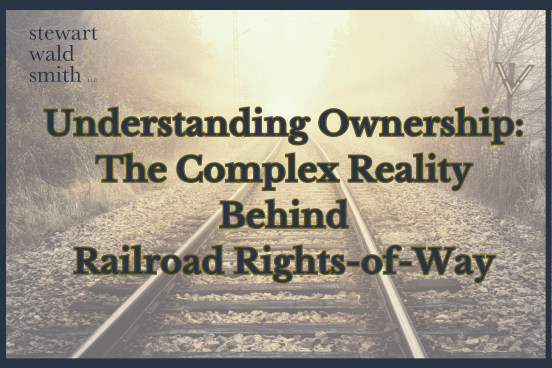Understanding Ownership
Understanding Ownership: The Complex Realty Behind Railroad Rights-of-Way

By: Jackie Tebbe
Landowners across the country who own property along a railroad right-of-way usually don’t spend too much time thinking about the land within the railroad corridor, and that’s perfectly understandable. Often, even though the trains don’t frequent the tracks and it’s become a rare sight to see a train pass by, landowners think the railroad still owns the land. After all, there used to be a railroad there, and it’s easy to assume, because the railroad managed and maintained the corridor to the exclusion of others, the railroad owns the corridor land outright, even where the railroad appears long gone.
However, in reality, the land within railroad rights-of-way across the United States are owned in many ways, and often, railroads only own the rights to use their corridors for a railroad and do not actually own the land outright.
Determining actual ownership interest in a railroad right-of-way requires a title search, which is often complicated, costly, and time-consuming. Through the title search we are able to acquire vital information, namely whether the railroad owns the land itself or simply the rights to use the land for a specific (railroad) purpose.
Railroads acquired many of the parcels of land used to establish their lines across the country through recorded deeds. However, in other instances, there are alternate notations on historical railroad maps about how the railroad gained possession and control of the land. These recorded documents tell a researcher how the railroad acquired its interest in the land from the original landowner and answer the following questions:
-Did the railroad gain an easement to use the land for the railroad purpose but did not obtain fee simple ownership?
-Did the railroad obtain the land outright without limitations or restriction from the landowner in a fee simple transfer?
-Was the land condemned for “a railroad purpose”?
Answering these questions becomes an important component in the research Stewart, Wald & Smith does for landowners in every rails-to-trails case. If our team can determine that the landowner in the 1800’s or 1900’s conveyed an easement to the originating railroad (in other words, simply the right to use the land for a railroad and not a trail), then then the current-day landowner along that same stretch of corridor can potentially recover money damages in a rails-to-trails case. An easement means the current-day landowner adjoining the railroad corridor has reversionary rights to the land within the railroad right-of-way. However, the Trails Act prevents that reversion from happening and instead authorizes the land’s use as a recreational trail. This action potentially triggers the landowners right to money damages under the Fifth Amendment of the United States Constitution.

Did you receive our mailer, or have any questions for us? We’re here to help you take the next step for just compensation.
Notable Success Examples
-
In Haggart v. United States, our attorneys recovered $177,400,000 on behalf of 254 landowners in King County, Washington, along a 25.45-mile trail.
-
In Raulerson v. United States, our attorneys recovered $33,300,000 on behalf of 264 landowners in Beaufort County, South Carolina, along a 25.05-mile trail.
-
In Smith v. United States, our attorneys recovered $26,477,000 on behalf of 29 landowners in King County, Washington, along a 25.45-mile trail.
-
In Ansley Walk v. United States, our attorneys recovered $18,416,000 on behalf of 5 landowners in Fulton County, Georgia, along a 1-mile trail.
-
In Furlong v. United States, our attorneys recovered $14,200,000 on behalf of 272 landowners in Albany, New York, along a 10.94-mile trail.
